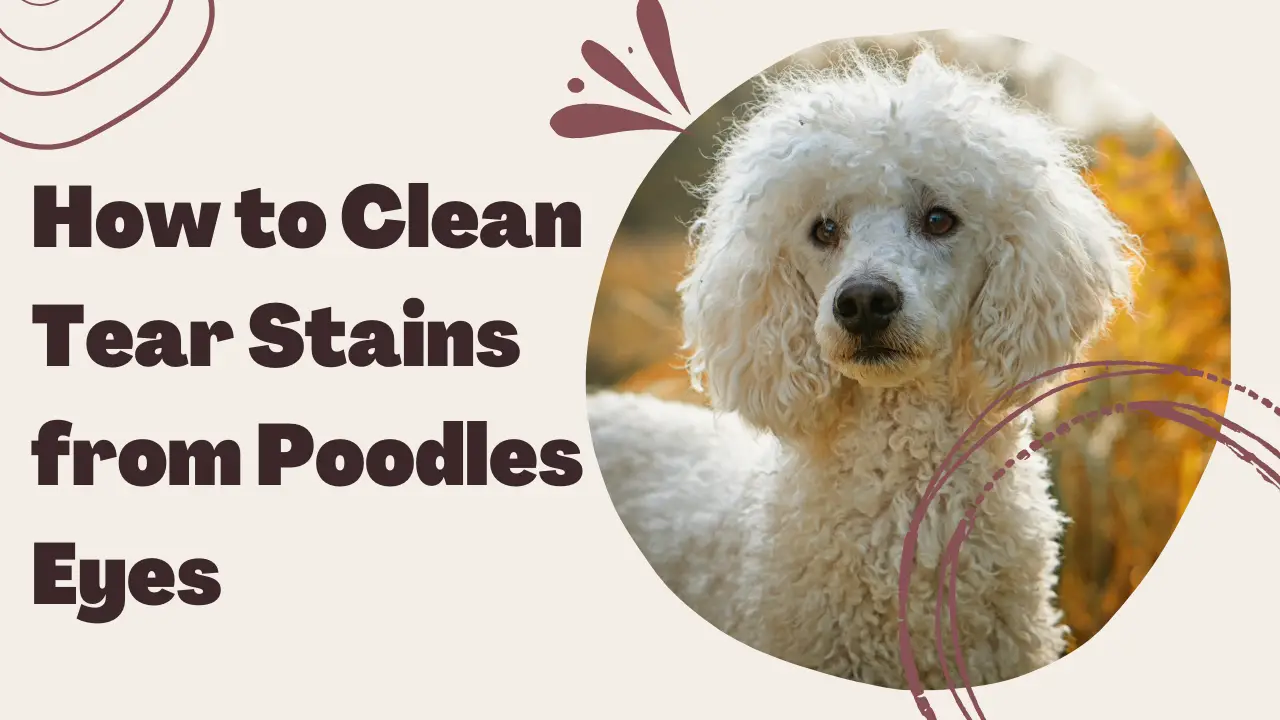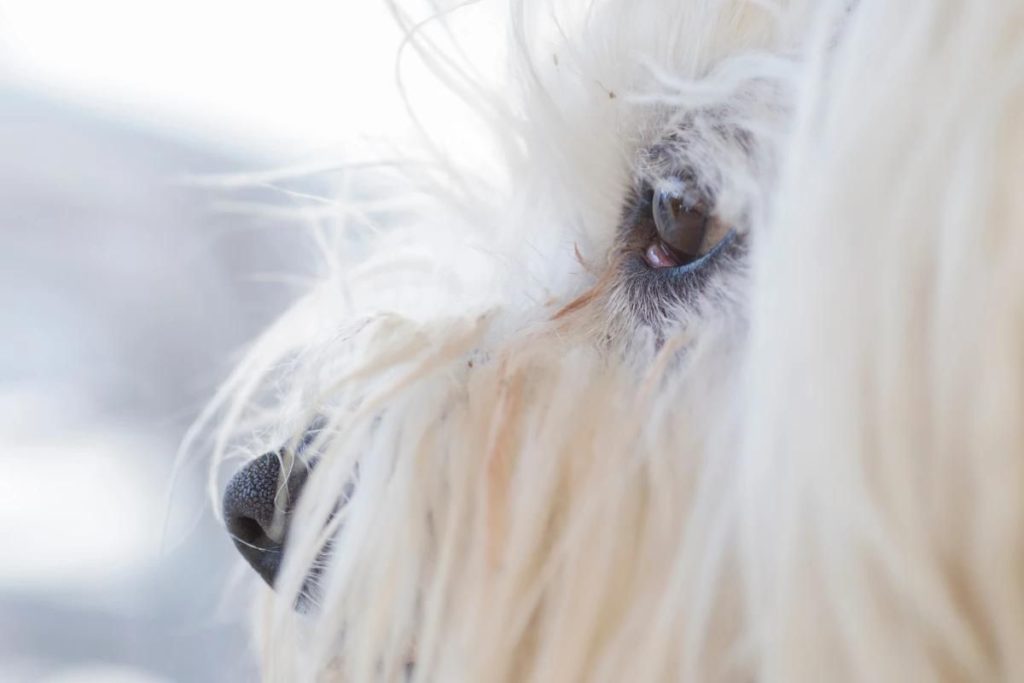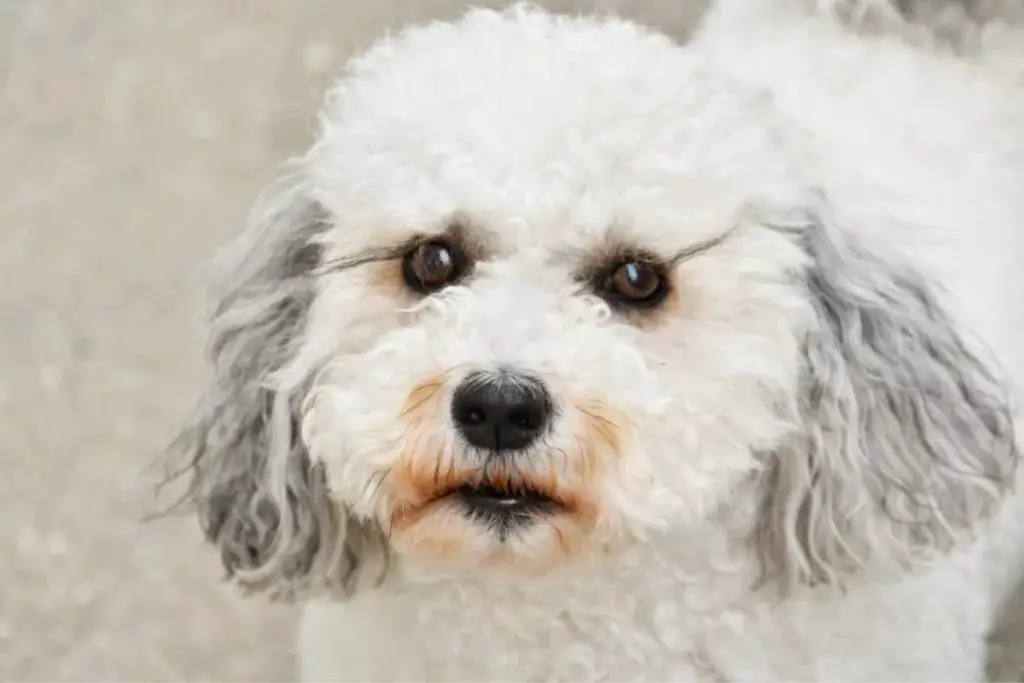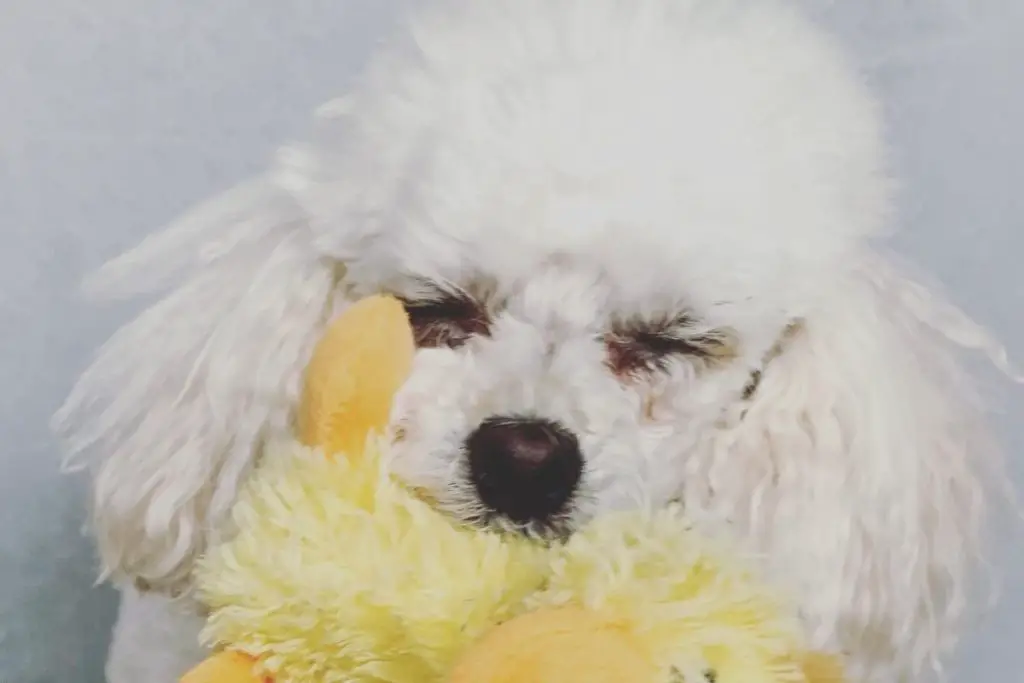Have you ever wondered why do poodles have tear stains? If you’re not familiar with tear stains, they’re when the eyes produce a lot of water and stain the edges. It’s more common in dogs, especially Poodles, as they can be detected easily on their hair. Most of the time, tear stains are harmless; however, there could be underlying reasons why they are happening.

Don’t worry, though; this is a very common condition in Poodles; however, it’s essential as a dog owner you understand why your dog gets them, how to detect them, and how to remove them. To help you know more, keep on reading.
What Will You Learn? 👇
why do poodles get tear stains?
Poodles have a unique coat that is often subject to tear stains. These stains are usually caused by excessive tear production, which can be due to eye irritation or dry eye. Ear infection in one ear can also cause the eye on the same side of the head to produce more tears than usual. Also, if you have a puppy, then teething might be also a cause fo this.

Read our Smart Poodles - Smart Tricks eBook for only $2.99
Dive into a treasure trove of engaging tricks and tips designed specifically for your poodle!
The most possible cause of tear stains is allergies. When a dog has an allergy, their skin becomes inflamed and itchy. This can lead to excessive licking and scratching of the face, which in turn leads to stains.
While there are other causes for tear stains, like bacterial or fungal infections or even cancer, they are rarer than allergies. Poodles are particularly prone to these allergies because their hair is so thick that it traps more allergens than other breeds. Some dogs may be allergic to something in their diet or environments like pollen or dust mites.

Epiphora is a condition that arises from a cosmetic issue or underlying medical condition such as an infection, corneal ulcer, or something more serious. However, if the tear stains next to their eyes spread, it’s likely more of a Poodle’s hair will have a range of different fungi and bacteria living in their hair. If tear stains aren’t treated properly, it can trigger yeast infections causing further health complications.
How to clean Tear Stains From Poodles
If you find your dog has tear stains and you don’t know how to clean poodle eyes, then you don’t need to take them to a vet in the first instance. In fact, as a dog owner, you can try cleaning them first to see if they go away. To do this, you will need to do the following:
Trim their facial hair near to the stain
The first correct step is to effectively trim their hair around the eyes. You should get a small pair of scissors and slowly cut around the discolored hair to do this. If your Poodle is quite excitable or nervous, you might want someone else to do this, like a professional groomer, while you hold them still in your lap or vice versa.

Gently clean the stain around the eye
Now you will want to clean them and be thorough around their eyes. The best way to do this is using a pet-friendly saline solution or chamomile tea kept at room temperature. We also recommend using these products:
Ideally, you should use an allergy-friendly product that is possibly plant-based and hypoallergenic. Sometimes even water will do the job. Once you’ve chosen the liquids, soak them in sterile gauze in a bowl and gently rub them around your dogs’ eyes. When doing this, remove any excess hair or sticky fluid from their eyes.
Thoroughly Dry the Skin
After wiping, make sure there is no moisture or discharge surrounding the eye. To do this, you should get a small towel and wipe it.
The reason tears produce a colored stain on Poodles is due to a chemical called porphyrin which has iron in it, making the dark brown or reddish tear you see on their face.
Use a topical treatment
Following this, you should use a pea-sized amount of topical paste on the tear stain. You must do this as it creates a barrier that repels water from their eyes and limits moisture. Therefore keeping bacteria and fungi at bay. If you’re unsure what topical paste to use, speak to your local vet.

Wipe away any remaining paste
To stop you from overapplying or leaving too much paste on the skin, wipe away any remaining paste that sits outside the tear duct.
Reapply every day for 7-10 days
Following this, repeat the process and apply this every 24 hours. You must do so to create a water-repellent material. You will want to continue doing this for up to 10 days or when it disappears.
poodle tear stains home remedy
Some home remedies you can try are using hydrogen peroxide and Rosehip seed oil. You can easily get hydrogen peroxide from your local pharmacy to remove stains. On the contrary, Rosehip seed oil tends to be very expensive however can be very effective for cleaning them.
If you want to maximize the effectiveness, you can always combine the two; this might be the best home remedy to help remove stains on a white Poodle.
There are also more home remedies you can try, such as:
- Corn starch on its own or combined with boric acid. Note that this can be a tad dangerous for dog breeds with sensitive skin and can irritate their eyes.
- Try adding vinegar to drinking water. There’s no definite guarantee that this will stop tear stains, and the flavor may prevent your dog from drinking a lot of water.
Note that these are just home remedies that might initially remove the stain. Just because it has been removed, there might still be an underlying issue that may need to be addressed by a vet.
How to prevent tear stains in Poodles
Poodles can easily suffer from separation anxiety and cry on their own if left for too long at home.
If you own a Poodle and just want to take caution about them getting tear stains in the future, you can do the following to prevent them:
Visit a vet
One of the first things you should do to stop tear stains is to prevent or be knowledgeable about any health conditions your dog might have. A good idea is to take them to the vet every 6 months for a routine checkup to have any health issues ruled out. During this time, you should also aim to get your dog allergy tested to see if any allergies could cause it.
Review their diet
Important thing to consider is the amount of food they consume; sometimes, if a Poodle is in a protein deficit, they can have tear stains appear. To prevent this, you can add some lightly grilled liver with no oil to its diet. You might also wish to supply your Poodle with food supplements like probiotics 2-3 times a week. The more good bacteria they absorb, the less likely bad bacteria and fungi will be able to grow.
Remove allergy triggers
If you know your Poodle has allergies that could cause this, you could try reducing their risk of an allergy flare-up by doing the following:
- Washing your Poodle or their paws every time you bring them home from being outdoors
- Vacuum your house daily to remove any potential allergen particles
- Make everyone in the house remove their shoes upon entering
- Have air purifiers in your home
Don’t give puppies unfiltered tap water
Tap water can often contain carcinogens and chemical agents full of toxins, causing many health problems. Sometimes it contains chlorine, mercury, and fluoride, which can be toxic to Poodles. A lot of the time, the agents in tap water are often unknown and could trigger stains. So when possible, use a filter at home before giving your Poodle tap water, or use bottled water.
Conclusion
Overall, all Poodles are prone to having tear stains regardless of their coat color. Just because it’s the most visible on white-coated breeds does not mean it’s not detected on other ones. To check for tear stains, always feel the hair around your poodle’s eyes to see if it’s damp. Learning how to remove poodle eye stains is beneficial for you as well as your dog.
Moreover, you must take a Poodle to a vet twice a year to rule out any possible health conditions that could trigger tear stains or review why they’re getting them. Don’t be alarmed, though; this is a very common health condition in Poodles and something that you can manage.
Has your Poodle had tear stains before? Share your experience in the comments.
Marko is the founder and author at PoodleHQ, where he blends profound expertise with formal training in Animal Behavior and Canine Genetics. With multiple generations of poodles under his care, he’s a breed connoisseur, honored with the Canine Care Excellence Award and lauded by the International Pet Enthusiasts Association.

